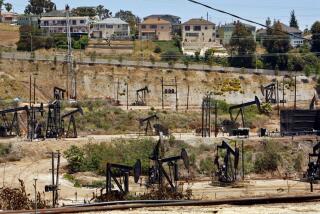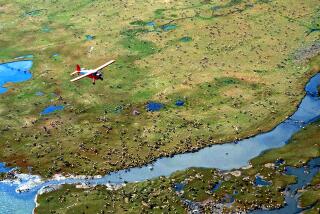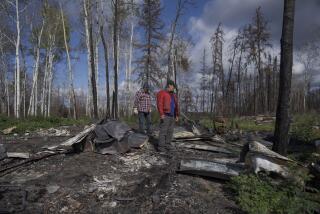Oil Report Shifts Focus Off ANWR
SEATTLE — The sprawling National Petroleum Reserve-Alaska on the remote Arctic coast contains four times more oil than previously believed, with deposits even greater than those in the Arctic National Wildlife Refuge, federal geologists reported Thursday.
But the U.S. Geological Survey said the deposits are less concentrated and more remote than ANWR’s, and would prove more lucrative to exploit only with a substantial increase in oil prices.
The long-awaited report sets the stage for the Bush administration’s plan to open an additional 9.4 million acres of the petroleum reserve to oil and gas leasing in 2004, a move that would expand the industrial footprint on Alaska’s North Slope into one of the most remote and rugged reaches of the North American continent.
The last official assessment of oil resources within the 23.5-million-acre petroleum reserve, conducted in 1980, estimated there were only about 2 billion barrels of oil beneath the landscape of rolling tundra, shallow ponds, lagoons and sand dunes.
But new seismic technology and recent discoveries by the oil industry on the outskirts of the reserve allowed USGS geologists to get a better look, and they now say there is likely between 5.9 billion and 13.2 billion barrels of oil in the petroleum reserve, with a mean estimate of 9.3 billion barrels.
By comparison, federal lands within the Arctic refuge--the subject of a contentious debate in Congress this year before the Senate voted against opening it for oil drilling--contain only 4.3billion to 11.8 billion barrels, with a mean estimate of 7.7 billion barrels.
Those estimates are for what could technically be recovered from the two areas, however, and they do not take into account the far more important question of economics. The Arctic refuge contains less oil and its development is more fraught with environmental controversy, but its oil is much closer to existing roads and pipelines and lies in larger, more easily developed pools, USGS officials noted.
The refuge’s oil is largely concentrated within a 1.5-million-acre section of the coastal plain in reservoirs as thick as 300 feet. The oil in the petroleum reserve, government geologist Ken Bird said, lies in reservoirs only about 50 feet thick, stretched across an area 300 miles wide and 200 miles from the coast inland to the Brooks Range.
“That’s a huge, huge area, and a very important factor, because in an economic analysis we have to evaluate the cost to transport any discovered oil, which means you must calculate the cost of building pipelines over to the main pipeline at Prudhoe Bay,” Bird said.
Bush administration officials were quick to emphasize that the economics of production still favor development of the refuge, which lies on the other side of Prudhoe Bay, to the east.
“The significant thing about this report is it brings out the fact that, at $20-a-barrel oil, there is very little economic oil in the NPRA, and there is significant economic oil in the [ANWR] ... area,” said Camden Toohey, the Interior Department’s special representative in Alaska.
As long as oil prices remain below $35 a barrel, the USGS said, “a larger volume of technically recoverable oil would be economic in the [ANWR] ... area.” Once prices exceed $35 a barrel, it said, NPRA and ANWR “would have nearly equal volumes of economically recoverable oil.”
Alaska crude oil prices currently are about $27 a barrel, but have dipped far lower over the last few years.
Opponents of drilling in the Arctic refuge have conducted a massive lobbying campaign this year to protect the narrow, fragile coastal plain there. They said the new government estimates make it clear that the refuge is not the only alternative for developing oil in the Arctic area.
The USGS report, said Adam Kolton of the Alaska Wilderness League, “is the final nail in the coffin for Arctic refuge drilling in this Congress. No one who’s concerned about increasing oil production in Alaska can with a straight face say the only option is the refuge.”
But conservationists said they were concerned that the government is moving forward with oil development on millions of acres of Arctic coastland without considering permanent protections for some of the most sensitive areas.
The petroleum reserve is a summer nesting and molting area for millions of birds. It contains the largest lake in the North American Arctic and its longest river, the Colville.
In response to concerns from the conservation community, the federal Bureau of Land Management recently removed 601,000 acres from the original 9.6 million acres of the northwest NPRA under study for oil leasing, including the entire Colville River watershed and one of its tributaries, the Awuna River.
BLM spokesman Ed Bovey said Thursday that the agency has decided not to recommend a specific oil leasing strategy in the draft Environmental Impact Statement, due in December. “I think they [agency managers] just wanted to get a better feel for what the public thought before they chose a course of action,” he said.
The BLM has scheduled a lease sale June 3 on 3 million acres in the northeast section of the petroleum reserve, an area originally leased in 1998. The decision to hold new leases came after Phillips Alaska, which operates the 429-million-barrel Alpine field just outside the NPRA, announced it had discovered oil in several wells drilled under the initial lease sale.
Phillips has not said how much oil it found, and spokeswoman Dawn Patience said the company would have no comment on the new USGS estimates. Likewise, BP Exploration Alaska, which drilled in the petroleum reserve last year, did not comment on the report.
More to Read
Sign up for Essential California
The most important California stories and recommendations in your inbox every morning.
You may occasionally receive promotional content from the Los Angeles Times.










